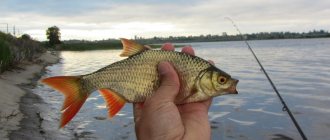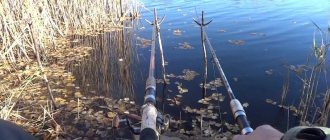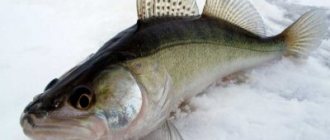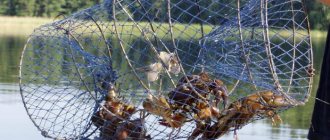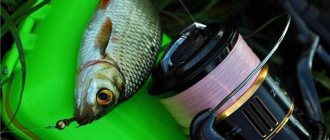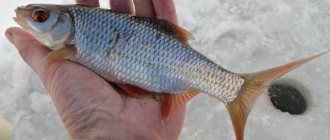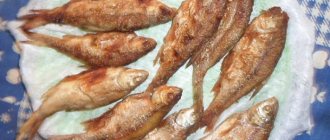The rudd (Scardinius erythrophthalmus) is a medium-sized representative of the carp family (Cyprinidae) with an average size of 15-20 cm and a weight of 100-300 g. It inhabits standing and flowing water bodies in Europe, Africa, New Zealand, North America, and Central Asia. In Russia, it lives en masse in the basins of the Baltic, Caspian, Azov and Black Seas. It has a long life cycle, which is 18-19 years. Under optimal development conditions, it can grow up to half a meter and gain weight over 2 kg.
Description of the species
The exterior features served as the basis for the appearance of the official and everyday names of the fish - rudd and rednose. Also mistakenly used are the nicknames red-eye, soroga, sorozhka, sorocha, which refer to an outwardly similar, but relatedly distant species - the common roach (Rutilus rutilus). This taxon forms its own unique forms - Aral, Siberian (chebak), Caspian (vobla), Azov-Black Sea (ram), to which representatives of the genus Scardinius have no relation. Against this background, another popular name looks incorrect and somewhat absurd - red roach, in which the names of two different species are mixed at once.
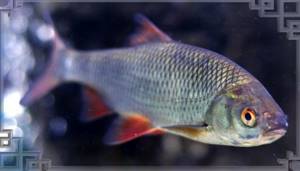
What does a rudd look like?
The fish has a rather expressive appearance, which is characterized by:
- oval, flattened body;
- dark back with a green tint;
- full lateral line;
- silvery, moderately large scales of the cycloid type (with a rounded posterior edge);
- semi-upper mouth;
- bright red color of fins;
- large eyes with orange-amber irises.
Depending on the specific living conditions, the shade of the bottom and water, and the amount of vegetation, the camouflage color of the body also changes, which can acquire reddish, golden, or olive tones.
Species of rudd
In addition to the main taxon, experts identify three more related forms, which have a narrow range, low numbers and are in danger of complete extinction:
- Scardinius racovitzai is a small, heat-loving species that lives in thermal springs in western Romania. It grows up to 8-9 cm. It has a light body and yellow-pinkish fins. It adheres to shallow depths with an abundance of algae and a muddy bottom, which is rich in benthic organisms.
- Scardinius graecus is a fairly large fish with a maximum size of up to 40 cm. It has a flattened head, giving the body an angular-humpbacked shape. It inhabits the large freshwater lake Iliki in the vicinity of Thebes (Boeotia Prefecture, Greece), which is why this species is officially called the Iliki, or Greek rudd.
- Scardinius scardafa is an endangered taxon that previously lived in Southern Europe, the Balkans, and the Iberian Peninsula. Today the range has shrunk to the deep-water Lake Scanno in the Italian region of Abruzzo. It is distinguished by a high body and rounded ventral fins. Grows up to 35 cm in length.
To learn more:
The royal fish of the sturgeon family - sterlet
Additional confusion in the classification of the species is introduced by the sea rudd, which belongs to its own generic taxon Tribolodon and has an elongated cylindrical body, similar in shape to dace or podust. This is the only representative of cyprinids capable of feeding for a long time in Pacific water with a high level of salinity (the Sea of Okhotsk and the Sea of Japan, the coast of Sakhalin, the shelf of the Kuril and Shantar Islands). The geographical features of the area gave the fish another well-known name - the Far Eastern rudd. The local name is also often used - ugai. The genus includes small-scaled (Tribolodon brandtii) and large-scaled (Tribolodon hakonensis) forms.

Rudd and roach - what's the difference?
Despite the strong external similarity, it is not difficult to accurately identify each species if you know certain physiological and exterior nuances. The main differences between rudd and roach are given in the table below:
| Sign | Rudd | Roach (roach) |
| Eye color | Orange iris with dark spot | Yellow iris with blood red spot |
| Pharyngeal teeth | 8 double row serrated | 5-6 single row non-serrated |
| Mouth | Semi-upper | Final or semi-bottom |
| Number of scales in the lateral line | Up to 42 | Up to 48 |
| Dorsal | 8-9 rays (moved behind the ventral fins) | 10-12 rays (at the level with the fins) |
Also, the roach is always covered with an abundant layer of mucus, which is practically absent in the rudd.
What do fish look like?
The fact that rudd and roach are similar is not surprising. After all, they have one family – carp. However, it is worth taking a closer look at each of the fish. Rudd looks like this:
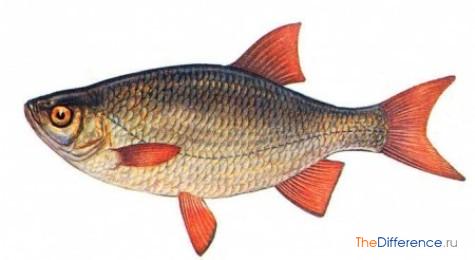
Rudd
And this is a roach:
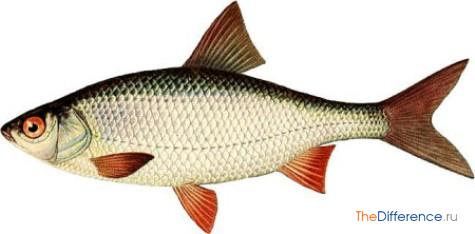
Roach
Now let's talk in more detail about how to recognize these aquatic inhabitants. I must say, there are plenty of differences between them.
Habits and habitats
The shy and cautious fish avoids unnecessary attention from predators and waterfowl, so it gathers in small, very maneuverable flocks of several dozen individuals. Leads a sedentary lifestyle in well-warmed stagnant and low-flowing water bodies (ponds, lakes, canals, lowland rivers, oxbow lakes) with an abundance of shelter in the form of tall and floating vegetation. Does not like cold water, riffles, fast currents, open reaches, or rocky soil.
Rudd is a daytime fish of the upper and middle layers; it gets along well with young bottom-dwelling cyprinids (bream, crucian carp, tench), which do not compete with food. Often flocks of different species move synchronously one after another across a body of water, eliminating the risk of unnoticed predator attacks from any direction. From October to early March it is in wintering pits. In early spring it feeds actively, gaining strength before spawning. After spawning, a long feeding phase begins, which lasts until mid-autumn.
To learn more:
The best weather for pike fishing
In Russia, the habitats of the rudd are limited to areas with a warm or temperate continental climate, which maximally promotes the development of aquatic vegetation. The fish is found everywhere in the middle zone and southern regions. Much less common - in the north-west of the European part of the country and in the Urals. And it’s completely absent from Siberia.
How to distinguish a roach from a rudd
How to distinguish a roach from a rudd because they are so similar and an inexperienced fisherman can easily get confused as to whether he caught a rudd or a ram. But there are still differences: the rudd’s mouth is sharpened to grab food from the top layer of water and its mouth is raised to the top. The roach is more accustomed to looking for food at the bottom and therefore its jaws are turned to the bottom for easier search for food.
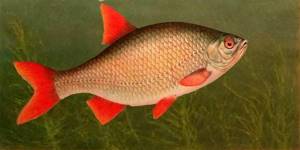
This is Rudd
Very often, roaches enter into non-marital relationships with other fish species, which leads to new hybrids. This is reflected in the shape of the roach's body. And in the end, it is very difficult to give an exact definition of whether you caught a roach or a bream, or maybe a white bream, in general, father-sister-brother-son.
What does the rudd eat?
The diet is based on plant foods - plankton, filamentous and attached algae, duckweed, succulent shoots of sedge, reed, pondweed, horsetail and buckwheat. Such flora contains many useful but bitter substances (polyphenols, glycosides), which can give the meat an unpleasant herbal taste. The fish also readily eats insects, worms, larvae, small crustaceans, rotifers, freshwater hydras and mollusk eggs, which it skillfully removes from the leaves of egg capsules and water lilies. When there is a lack of edible vegetation, the rudd switches to zooplankton and often descends to the bottom in search of benthic organisms. Large individuals can eat fry.
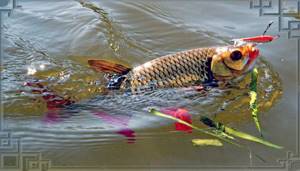
Lifestyle and nutrition
The rudd leads a sedentary lifestyle. Small fish gather in small schools, while large rudd stays apart. The fish avoids open areas and river rapids. It lives mainly in river bays, lakes and ponds with lush thickets of reeds. In the warm season, it moves into the water floor and rises to the surface. With the onset of cold weather, the rudd needs less food and looks for food in the bottom layer of water, often in reed thickets.
The rudd is an omnivorous fish. Main fish food:
- Aquatic insects and their larvae;
- Shellfish caviar;
- Worms;
- Filamentous algae;
- Aquatic plants;
- Duckweed.
Large rudd does not miss the opportunity to feast on juvenile fish of other species.
Features of reproduction
The spawning period begins late (end of April - June) at water temperatures of +16-17°C. Eggs are laid in 2-3 portions in very shallow areas (15-50 cm) with an abundance of bottom vegetation. Sexual maturity occurs at 2-4 years with a height of 10-12 cm. For its small size, the rudd is very prolific, even small females lay more than 10 thousand eggs per season. A large individual weighing up to 300 g (20-23 cm) is capable of giving birth to hundreds of thousands of fry. But usually only a small part of the young survive. A huge number of eggs and hatched larvae die on greatly shallowed floodplain spawning grounds. The late timing of spawning also has an effect - during this period, many fish completed the breeding process and began active feeding, massively exterminating clutches and young rudd.
The incubation period of eggs lasts 3-4 days. When a fry swims, it immediately hides in the vegetation near the surface of the water, where it feeds on zooplankton all summer. As autumn approaches and most of the floating flora disappears, the young animals move to shallow areas or closer to the shore in search of shelter in reed thickets.
To learn more:
Description of the chub - a large fish of the carp family
Fishing for rudd
More often, targeted fishing for rudd is carried out for its use as live bait. Pike, pike perch and a number of other predatory fish readily bite on small rudd. Large individuals can be used for preparing fish dishes. The main thing is to know how to cook fish and get rid of the specific smell.
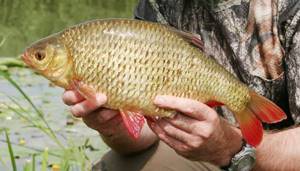
Fishing for rudd in open water
Rudd shows high activity from the second half of spring until the onset of autumn cold weather. Feeds throughout the day. Active search for food continues until lunch. As a result, the best rudd bite is observed in the first half of the day. But this does not mean that catching it after lunch is a useless exercise. If you successfully determine the habitat of the fish, then fishing for rudd will be effective until dusk.
What does the rudd bite on?
The omnivorous nature of the fish provides ample opportunities for successful fishing during the warm season. The main plant and animal baits are:
- aromatic or sweet dough (honey, anise, caramel, hemp);
- bread crumb (white and black);
- mastyrka;
- steamed pearl barley, oats, peas;
- hominy;
- maggot, bloodworm, caddisfly;
- earthworm and dung worm.
Large rudd can be seduced by the game of very small (3-5 cm) spinners, spinners and wobblers weighing 3-6 g. In this regard, Mepps Syclops, Yo-Zuril-Minnow 44, Mepps Aglia Long, Salmo Hornet H4F spinner baits have proven themselves well. .
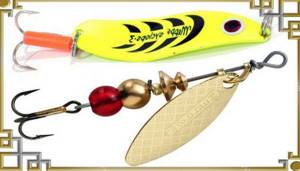
Differences between rudd and roach: appearance and habitat
At first glance, roach and rudd are similar. An inexperienced fisherman can be deceived, so we will tell you everything about the appearance and habits of both representatives of their kind. Let's find out in more detail what rudd and roach really are.
Beginning fishermen often confuse roach and rudd - this is not surprising, they are really similar, since they belong to the same family - cyprinids . But there are also significant differences between them. These are the ones that will be discussed in the article, which will tell you in detail how to recognize a catch.
Appearance
The main difference between these fish is the color of their scales.
Roach is only silvery, while rudd has a golden tint. The older and larger it becomes, the more saturated the color becomes.
The fins differ in structure and color. In rudd they are bright red, in roach they are red-gray or gray, this is largely due to their habitat. The number of rays of the dorsal fin will accurately indicate the type of fish. The rudd is decorated with 8 - 9 ribs, and the roach - 10 - 12 pieces.
Also note the placement of the dorsal fin in both species. The roach fish is distinguished by the parallel construction of the pelvic and dorsal fins; they, like soldiers on the parade ground, begin in one place. In the rudd, the beginning of the fin on the back is located closer to the tail. The golden beauty is wider and thicker, and the body of the roach is more elongated and thin.
If the definition is difficult, take a look at the color of the eyes, it also varies. The rudd is distinguished by a yellow or orange color; there may be red blotches. Roaches have mostly red eyes . These individuals have differences in the structure of their mouth. The roach has a straight mouth and a rudd has a curved mouth with a yellow edge.
Attention! The body of the roach is slippery to the touch, as it is covered with mucus.
Habitat
Both representatives of their kind have favorite places of life, where you need to look for them.
Rudd
This fish can be found in almost any body of water in Europe and Central Asia. It is found in almost every lake, pond, quarry and river. Prefers quiet creeks, backwaters and oxbow lakes. Lives in shallow waters. A prerequisite is the presence of underwater vegetation. It does not like fast currents, so you need to look for it in standing water or in places where the water movement slows down.
For example, when fishing in a river, these can be channels, branches or closed sections of the riverbed. It is extremely rare on clean muddy bottoms. Life expectancy is up to 19 years, growing very slowly. Large specimens are rare. It can grow up to 50 cm and weigh up to 2 kg. The most common size is 50 - 150 g.
Roach
It has a large number of subspecies, for example: ram, roach, chebak, etc. Distributed from the Urals to New Zealand. It can be freshwater or not. The common roach is found in lakes and rivers with weak currents.
Lives in snags, under the shade of hanging trees and protection of algae. It gathers in large flocks of different sizes. Among them there are several large individuals. Small and medium-sized roach are not shy, and trophy specimens are very cautious.
They live up to 20 years and can weigh up to 3 kg. The more common weight is from 50 to 500 g.
Taste qualities
Both types of fish are not distinguished by their fat content and are quite bony. Roach is more suitable for frying and boiling. Rudd is usually dried or dried.
What do they use to catch and how do they bite?
Large rudd and roach can be successfully caught using feeder, float and winter fishing rods. The difference may be the attachments. The rudd does not mind hunting, although it is not a predator. She often bites on worms and bloodworms. There are known cases of fishing with spinning rods.
The curved mouth of the redfin fish allows it to grab prey from the surface of the water, which it successfully uses and, if possible, eats insects that have fallen into the reservoir. Roaches bite well on semolina, dough, maggots, and pearl barley. Prefers to search for food in the bottom layer. When bitten, it often completely sinks the float and provides good resistance.
It’s difficult to immediately understand what size the prey will be, which adds excitement and interest to fishing.
Important! The roach is a representative of peaceful fish, the large rudd has the habits of a predator.
The roach is common and moves around the reservoir depending on the season. Migration is observed in the spring before spawning and in late autumn to the wintering place. The rudd has a more sedentary lifestyle and rarely leaves its favorite places.
Main differences:
- scale color;
- coloring of fins and eyes;
- body shape;
- number of dorsal fin rays;
- the location of the fins relative to each other;
- mouth shape;
- the amount of mucus on the body;
- habitat;
- taste preferences;
- behavioral characteristics.
Fish can deceive mainly beginners with their appearance. Experienced fishermen distinguish them immediately by their characteristic features. Sometimes it is enough to look into the eyes of the catch or evaluate the structure of the mouth. After all, very often both species bite mixed together, especially not large specimens.
Source: https://1poklev.ru/plotva/razlichiya-krasnoperki-i-plotvy
Selection of baits
Despite the fact that these types of fish have certain differences, they are both perfectly caught with both plant and animal baits.
If you plan to fish, the following baits have proven themselves best:
- Bloodworm.
- Maggot.
- Flies.
These river inhabitants also bite well on crumpled dough, especially if various flavorings, such as anise drops, are added to it.
As practice shows, identifying roach and rudd is quite difficult, especially if fishing for the first time. But, despite the fact that both fish have external similarities and lead almost the same lifestyle, it is still possible to find differences between them; it is especially easy to identify the difference in eye color.
Fishing methods in winter and summer
Many anglers love roach not for its gastronomic qualities, but for the opportunity to fish all year round. If you take the right gear, you will definitely be able to return with a catch.
Open water fishing
Fishing for roach from spring to late autumn is carried out using several fishing gear. The choice depends on the angler's preferences.
It is considered a fishing classic. Today, an angler can choose a ku or a plug. All of them will provide a lot of fun if used correctly.
Ice fishing
In winter, roaches continue to bite, to the delight of many fans of ice fishing. Fishing is done in two ways.
- A float rod allows you to catch fish from the bottom. The fishing rod is equipped with a thin fishing line and a small float. Sometimes, instead of a jig, a sinker and a hook are mounted. The float should be located under water 2-3 cm from the surface; when bitten, it either floats up or goes under the hole.
- Tackle with a nod provides a unique opportunity to fish with baitless jigs throughout the entire water column. The roach will bite only if the game is played evenly with the same amplitude of oscillations. Each element of the gear must be in harmony with each other. Small light jigs require thin fishing line and. You can use this tackle to catch fish with bait in the form of bloodworms.
Photo 3. Roach on a rewinder.
General information about the track
In Siberia, this fish has a completely different name, where it is known as chebak. It has several names - chebak, roach, roach, soroga.
The population of this fish is the largest in all of Europe. There are several types, but their appearance is practically the same. There are differences only in habitat, behavioral characteristics and slight differences in appearance.
What does a track look like?
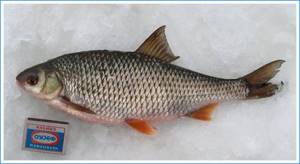
The appearance of the roach is known to every self-respecting fisherman; only those who have never been fishing can fail to recognize this remarkable individual. The back of the collar is slightly darker than the body, with tints of blue or green. It has a small red fin.
Habitat
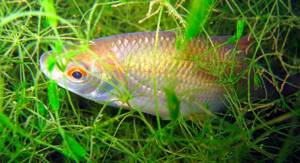
This fish is found throughout Europe. It can be caught in reservoirs of Siberia, in the basin of the Caspian and Aral seas.
It is very easy to find, because roach lives in large rivers, and even in small ponds and lakes. But, in order to catch it, you need to know the specific place where she spends her time.
To detect it, you just need to carefully examine the body of water in search of algae thickets in a place with a weak current. It can be found near trees or where it can find a lot of food.
First of all, you need to look for a path in lakes or rivers into which small streams flow or in those reservoirs on the banks of which there are many trees, especially willows. There are a lot of such places throughout Russia; you won’t have any difficulties finding them.
What gear is best to use?
No matter how rudd differs from roach, these types of fish still need to be caught in a similar way. Experienced fishermen say that it is best to catch them using a regular spinning rod. Moreover, it is recommended to select the size of the gear based on the width of the river itself in which the fishing will be carried out.
If you plan to hunt for rudd and roach, it is recommended to adhere to the following rules:
- these river inhabitants prefer to live in holes located close to the shore, so the first thing you need to do is throw the spinning rod into such places;
- if fishing is carried out in a wide river, it is recommended to cast the spinning rod into places with snags and bushes, since rudd and roach prefer to hunt from “closed” areas.
The most important point is choosing the right weight. To maximize the likelihood of catching fish, it is necessary to use a weight with a large mass, thanks to which the bait will move quite slowly.
As practice shows, both fish first attack prey moving at low speed.
When and what to catch sorog?
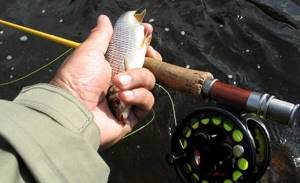
The most active roach biting time occurs a few days before and after spawning. This moment falls at the end of spring, beginning of summer. It is better to go hunting for a magpie in the evening or early in the morning. It will be caught on almost any tackle; there have been cases when this fish was caught on tackle that was not intended for it.
She was even caught on spinners and donks. Roaches will even attack artificial baits that imitate small fish found in a pond. Especially when she starts to feel hungry. Using any tackle, there is a chance to catch a trap instead of the intended trophy.
The best time of year to catch roach
You can catch it at any time of the year. She is especially insatiable at the end of May and beginning of July, when the spawning period begins. At this time, she attacks the hook herself and the biting practically does not stop. Larger specimens can be caught in winter near deep holes, where they like to hide from the cold.
Roach tackle
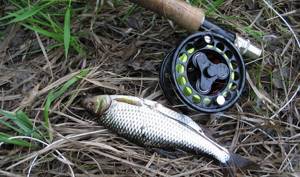
The best gear for catching sorog is:
- Float fishing rod , which is equipped with a very sensitive float that will not miss even a light bite.
- Fly fishing with a fly . They can be used to fish on the surface of a reservoir. Fishing with this gear is very exciting and interesting, because you can observe the behavior of the prey.
- Donka . Especially if it is equipped with a feeder, because the cat is always hungry and will not be able to swim past such a delicacy.
- Spinning rod equipped with small lures that imitate fry.
- Winter float fishing rod with bait in the form of a river crustacean.
Where does the rudd live?
This fish does not live in areas where there is a strong current. The habitats of these fish are different. They are found in river bays and oxbows, flowing ponds, both small and large lakes and reservoirs. Selects the quietest areas where reeds, grasses, water lilies and other vegetation grow.
In addition to food, there is always shadow there, which serves as a good refuge from predatory fish. In addition, there is some pattern. Closer to the coast, small fish live in shoals among algae and driftwood in polluted areas. Mature fish, although they come to the shores to feed, spend most of their time in the wild, picking up watery, overgrown heights far from the shore.
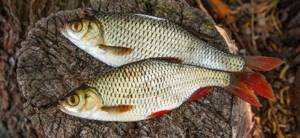
The main habitat of rudd is bays and oxbow lakes, in addition, flowing ponds and reservoirs where many different plants grow. Here she can often be found in company with bream, and. She leads an almost sedentary lifestyle, staying in one area of her choice.
Photo 2. On a small river.
General information about the track
In Siberia, this fish has a completely different name, where it is known as chebak. It has several names - chebak, roach, roach, soroga.
The population of this fish is the largest in all of Europe. There are several types, but their appearance is practically the same. There are differences only in habitat, behavioral characteristics and slight differences in appearance.
What does a track look like?
The appearance of the roach is known to every self-respecting fisherman; only those who have never been fishing can fail to recognize this remarkable individual. The back of the collar is slightly darker than the body, with tints of blue or green. It has a small red fin.
Habitat
This fish is found throughout Europe. It can be caught in reservoirs of Siberia, in the basin of the Caspian and Aral seas.
It is very easy to find, because roach lives in large rivers, and even in small ponds and lakes. But, in order to catch it, you need to know the specific place where she spends her time.
To detect it, you just need to carefully examine the body of water in search of algae thickets in a place with a weak current. It can be found near trees or where it can find a lot of food.
First of all, you need to look for a path in lakes or rivers into which small streams flow or in those reservoirs on the banks of which there are many trees, especially willows. There are a lot of such places throughout Russia; you won’t have any difficulties finding them.
Sorogi fish nutrition
How to catch more fish?
This fish eats almost everything. The main diet consists of insects, which she catches when they land on the water or fall from a tree:
- Mosquitoes
- Midges
- Grasshoppers
- flies
- Caterpillars
- Insect larvae
Fishing

Previously, when only valuable species of fish were important in fishing, if a fish was caught in a net, it was simply thrown away, so it died in huge quantities. Over time, this fish began to be appreciated, especially when the fishing industry began to actively develop. Even large industrialists caught it; it was harvested in huge quantities, several million kilograms.
For sale, it was smoked, dried and dried. Roach was very popular, because its price was low and the meat was very tasty. The smoked carcass was a little more expensive, the salted carcass was much cheaper.
Interesting facts about roach
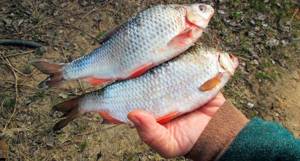
Some pretty fun facts about this fish:
- The track is so common all over the world that in many countries its image can even be seen on postage stamps.
- It is best to look for it in fresh rivers with a lot of algae. Usually specimens weighing 100-400 g are caught, but specimens weighing 2 kg have been caught several times in the lakes of the Urals.
- It is often confused with the rudd. But the most important distinguishing feature is the roach’s eyes; they have a bright red rim.
- The best time for fishing is when the reservoirs are covered with the first ice, and when it begins to melt at the end of winter.
- The track grows very slowly, ten-year-old individuals weigh only 300 g.
Roach and ram: fish or cooking method
As in the case of the name “ram,” many consumers of fish products think that “vobla” is nothing more than the name of a dish, not a fish. Most likely, this opinion was formed due to the fact that recently fishing for roach has decreased significantly.
The unsightly living conditions for this species of fish have contributed to a sharp decline in the roach population. There is absolutely no difference in the preparation of ram and vobla. But for some reason, true connoisseurs of dried fish believe that roach is much tastier than ram.
More such recipes on our website:
- Everyone knows that salted fish lasts longer. Therefore, in order to stock up on ram for future use, you need to know how to properly salt ram...
- For the average lover of dried and salted fish products, there is little difference between ram and roach. But connoisseurs claim that the roach is dried, the photo of which you...
- Like its relatives - ram and roach - dried roach is one of the most popular and sought-after candidates for “withering”, since in dried form the roach...
It might be useful to read:
- Positions in basketball, their meanings for players;
- Fitness bracelets for iOS devices Electronic bracelet for iPhone;
- Fencing master classes will be held in Tsaritsyno;
- Electric bicycles Electric bike with the highest mileage;
- Cycle lane sign Bicycle traffic signs and their meanings;
- Heart contusion: danger of injury from a blow to the chest;
- The history of the game basketball The history of basketball for children briefly;
- The children of the famous figure skater Irina Rodnina were persecuted. Son Rodnina where he lives;
When and what to catch sorog?
The most active roach biting time occurs a few days before and after spawning. This moment falls at the end of spring, beginning of summer. It is better to go hunting for a magpie in the evening or early in the morning. It will be caught on almost any tackle; there have been cases when this fish was caught on tackle that was not intended for it.

